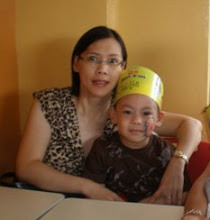We’re training our son Justin to become bilingual. We teach him both the English and Filipino versions of words. He knows that “hungry” and “gutom” are one and the same thing, for example, and he uses them interchangeably. This way, he understands quite well what we or others tell him or show him, regardless of the language it’s spoken. Below is a list of some English words and their Filipino translation that Justin knows by this time:
water; tubig
umbrella; payong
ball; bola
chair; upuan
car; kotse
light; ilaw
spoon; kutsara
fork; tinidor
mirror; salamin
pillow; unan
get; kunin
ride; sakay
write; sulat
sing; kanta
dance; sayaw
change; palitan
hide; tago
throw; itapon
spank; palo
wrong; mali
open; bukas
closed; sarado
Justin has yet to learn the Filipino translation of the following English words, though: paper, pencil, slippers, table, read, borrow, skip, hop, jump, run, walk, bow, clap, slide, stop, park, wash, dirty. But he knows what these words mean, and he uses them every so often.
My son is 2 years, 2 months, and 18 days old today.
water; tubig
umbrella; payong
ball; bola
chair; upuan
car; kotse
light; ilaw
spoon; kutsara
fork; tinidor
mirror; salamin
pillow; unan
get; kunin
ride; sakay
write; sulat
sing; kanta
dance; sayaw
change; palitan
hide; tago
throw; itapon
spank; palo
wrong; mali
open; bukas
closed; sarado
Justin has yet to learn the Filipino translation of the following English words, though: paper, pencil, slippers, table, read, borrow, skip, hop, jump, run, walk, bow, clap, slide, stop, park, wash, dirty. But he knows what these words mean, and he uses them every so often.
My son is 2 years, 2 months, and 18 days old today.

0 pensive thought/s:
Post a Comment